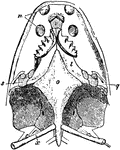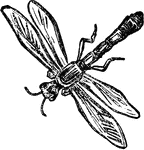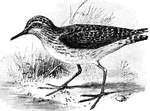
Muscular Cells
"Muscular cells of medusae (Lizzia). The uppermost is a purely muscular cell from the sub-umbrella;…
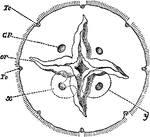
Aurelia Aurita
"Surface view of the sub-umbrella or oral aspect of Aurelia aurita, to show the position of the openings…

Corymorpha
"A, a hydriform person giving rise to medusiform persons by budding from the margin of the disc; B,…
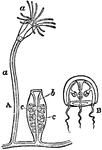
Campanularia
"Diagram of a colony of Campanularia, showing four forms of persons. A, portion of a fixed colony; a,…
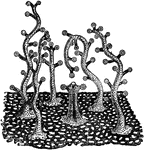
Millepora
"Enlarged view of the surface of a living Millepora, showing five dactylozooids surrounding a central…
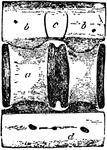
Shark Vertebra
"Lateral view of caudal vertebra of Basking Shark (Selache mazima). a, centrum; b, neurapophysis; c,…

Polypterus Skull
"Side view, with the membrane-bones. An, angular; ao, anteorbital; Ar, articulary; B, basal; D, dentary;…
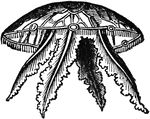
Acalephae
"Side-view, showing the tentacula hanging down in their natural position." — Chambers' Encyclopedia,…

Andromeda
"A genus of Andromeda polifolia of plants of the natural order Ericaceae, distinguished by a 5-valve…

Arquebus
"The first form of hand-gun which could fairly be compared with the modern musket. those of earlier…

Assignat
"After appropriating to national purposes the land belonging to the church, the French National Assembly,…

Astragalus
"A genus of plans of the natural order Leguminosae, sub-order Papilionaceae. The pod is more or less…
Auditory Nerve
"a, the osseous septum grooved for the passage of the cochlear nerve b, which terminates by a free end…

Aviz
"An order of knighthood in Portugal, instituted by Sancho, the first king of Portugal, in imitation…
Barometer
"A glass tube about 33 inches in length, open at one end, is completely filled with mercury, and being…
Barometer
"A cistern barometer, being that generally seen in weather-glasses or ordinary barometers. The tube…

Basil
"A genus of plants of the natural order Labiatae. The species are all natives of the tropics, or of…

Clematis
"A genus of plants of the natural order ranuculaceae having four colored sepals, no corolla, and fruit…

Cress
"A name given to many plants, of which the foliage has a pungent, mustard-like taste, and is used as…

Crowberry
"A small procumbent shrub, of the natural order Empetraceae, a native of the northern parts of the world,…

Denarius
"Denarius of the earliest kind: Having on the obverse a personification of Rome as a warrior with helmet;…
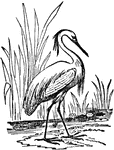
Egret
"A name often given to various species of Heron, particularly those which, at least during the breeding…

Thysanuran
"A typical Thysanuran (Machilis maritima). Female, ventral view. Mx1, Mx2, 1st and 2nd maxillae. ii-x,…
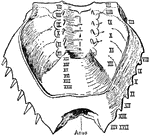
Limulus Polyphemus
"Ventral view of the posterior carapace or meso-metasomatic (opisthosomatic) fusion of Limulus polyphemus.…

Scorpion
"Ventral view of a scorpion. Palamnaeus indus, de Geer, to show the arrangement of the coxae of the…

Scorpio Embryo
"Embryo of scorpion, ventral view showing somites and appendages. sgc, Frontal groove. sa, Rudiment…

Limulus Polyphemus
"View of the ventral surface of the mid-line of the prosomatic region of Limulus polyphemus. The coxae…

Scorpion
"View from below of a scorpion (Buthus occitanus) opened and dissected so as to show the pericardium…
Scorpion
"Diagram of a lateral view of a longitudinal section of a scorpion. d, Chelicera. ch, Chela. cam, Camerostome.…

Limulus
"Diagram of a lateral view of a longitudinal section of Limulus. Suc, Suctorial pharynx. al, Alimentary…

Triarthrus
"Triarthrus Becki, Green. Dorsal view of second thoracic leg with and without setae. en, Inner ramus;…

Agnostus Nudus
"Four stages in the development of the trilobite Agnostus nudus. A, Youngest stage with no mesosomatic…
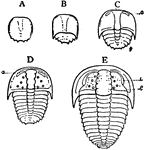
Sao Hirsuto
"Five stages in the development of the trilobite Sao hirsuta. A, Youngest stage. B, Older stage with…

Limulus Polyphemus
"So-called "trilobite stage" of Limulus polyphemus. A, Dorsal; B, ventral view." — The Encyclopedia…

Limulus Polyphemus
"Ventral view of Limulus polyphemus. 1 to 6, The six prosomatic pairs of appendages. abd, the solid…

Eurypterus Fischeri
"Eurypterus Fischeri, Eichwald. Silurian of Rootzikil. Restoration after Schmidt. The dorsal aspect…

Palaophonus
"Dorsal view of a restoration of Palaeophonus nuncius, Thorell. The Silurian scorpion from Gothland."…

Palaeophonus Hunteri
"Ventral view of a restoration of Palaeophonus Hunteri, Pocock, the Silurian scorpion from Lesmahagow,…

Prosomatic Limb
"Comparison of the sixth prosomatic limb of a recent scorpion (B), of Palaeophonus (C), and of Limulus…
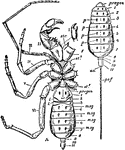
Thelyphonus
"Thelyphonus, one of the Pedipalpi. A, Ventral view. I, Chelicera (detached). II, Chelae. III, Palpiform…

Thelyphonus
"Thelyphonus sp. Ventral view of the anterior portion of the body to show the three prosomatic sternal…

Schizomus
"Schizomus crassicaudaius, one of the Tartarid Pedipalpi. Ventral view of a female with the appendages…
Schizomus
"Schizomus crassicaudatus, a Tartarid Pedipalp. Dorsal view of a male with the appendages cut short.…
Schizomus
"Schizomus crassicaudatus, one of the Pedipalpi. Lateral view of a male, II to VI, the prosomatic appendages,…
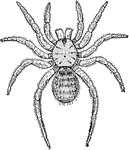
Liphistius Desultor
"Liphistius desultor, Schiodte, one of the Araneae Mesothelae. Dorsal view. I to VI, the prosomatic…

Liphistius Desultor
"Liphistus desultor, Ventral view with the prosomatic appendages cut short expecting the chelicerae…

Liphistius Desultor
"Liphistius desultor. Lateral view. I to VI, Appendages of the prosoma cut off at the base. o, Ocular…

Spider
"Ventral view of a male mygalomorphous spider. I to VI, The six pairs of prosomatic appendages. a, Copulatory…

Koenenia Mirabilis
"Koenenia Mirabilis, Grassi, one of the Palpigradi. A, Ventral view of prosoma and of anterior region…

Galeodes
"Galeodes sp., one of the Solifugae. Ventral view to show legs and somites. I to VI, The six leg-bearing…

Galeodes
"Galeodes sp., one of the Solifugae. Ventral view with the appendages cut off at the base. I to VI,…
Galeodes
"Galeodes sp., one of the solifugae. Dorsal view. I to VI, Bases of the prosomatic appendages. o, Eyes.…

